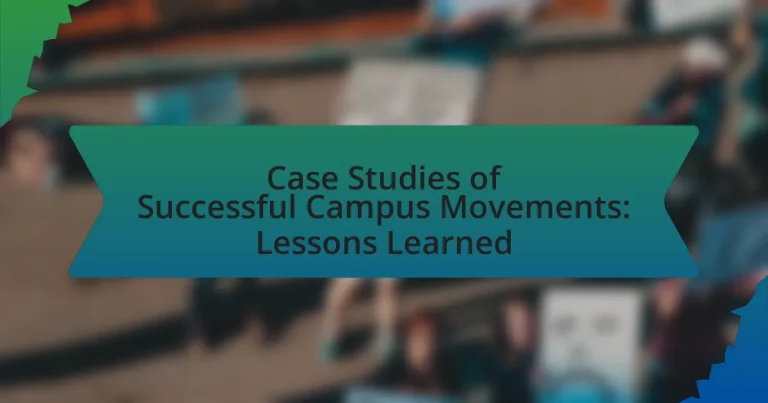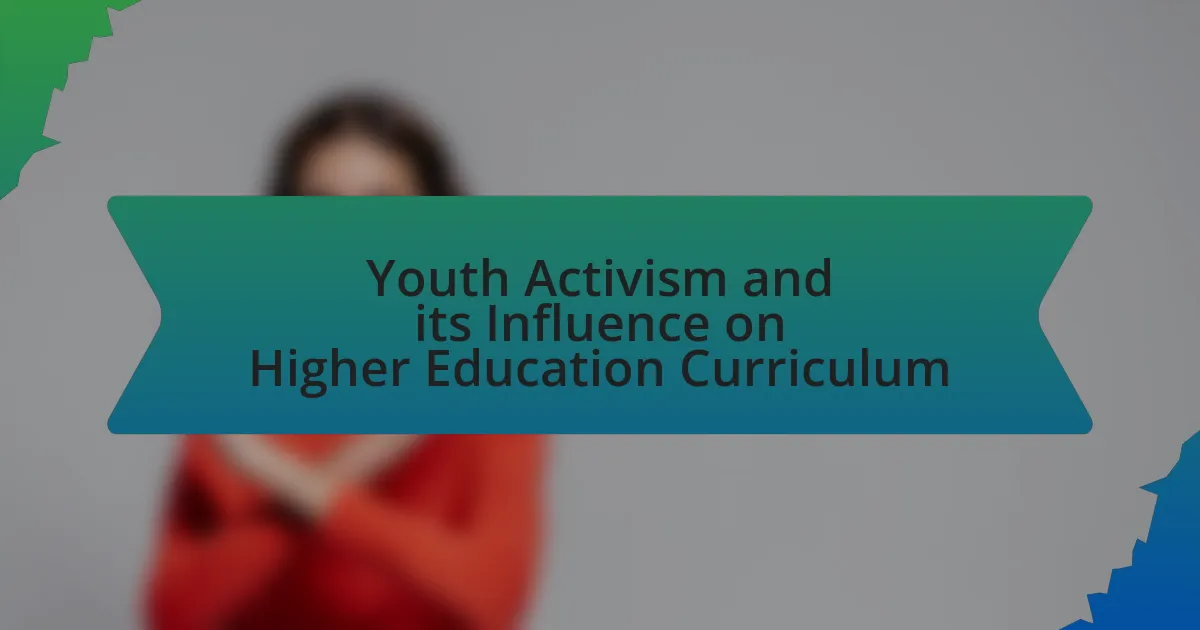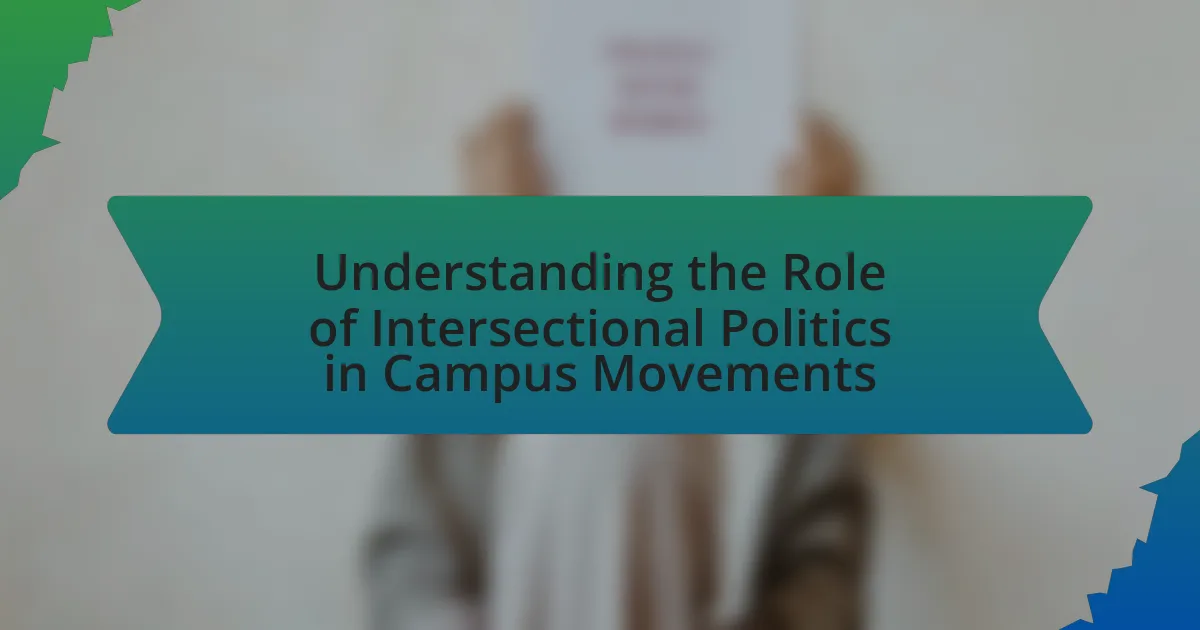The article focuses on successful campus movements, which are organized efforts by students advocating for social, political, or institutional change within educational environments. It outlines the criteria for defining success in these movements, including measurable outcomes, sustained engagement, and policy changes. Historical examples such as the Civil Rights Movement and the March for Our Lives illustrate the impact of collective student action. The article also discusses effective strategies for mobilization, the importance of coalition-building, and the challenges faced by campus movements, providing insights and lessons learned from past initiatives to inform future activism.
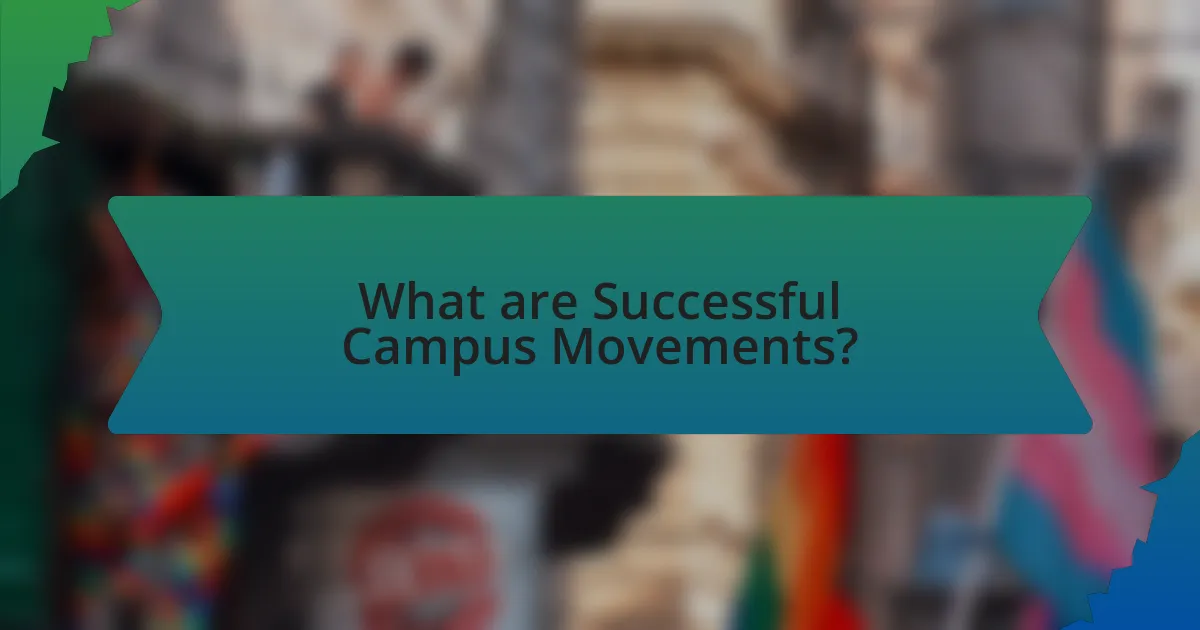
What are Successful Campus Movements?
Successful campus movements are organized efforts by students to advocate for social, political, or institutional change within their educational environments. These movements often focus on issues such as racial equality, environmental sustainability, mental health awareness, and tuition reform. Historical examples include the Civil Rights Movement on college campuses in the 1960s, which significantly influenced national policy, and the more recent March for Our Lives movement, initiated by students advocating for gun control following school shootings. These movements demonstrate the power of collective student action in effecting change and highlight the importance of grassroots organizing, coalition-building, and strategic communication in achieving their goals.
How do we define success in campus movements?
Success in campus movements is defined by the achievement of specific goals that address student concerns and lead to tangible changes within the institution. These goals often include policy reforms, increased awareness of social issues, and enhanced student engagement. For instance, the University of California, Berkeley’s Free Speech Movement in the 1960s successfully resulted in the establishment of free speech policies on campus, demonstrating how organized student activism can lead to significant institutional change. Such outcomes serve as concrete evidence of success in campus movements, highlighting the effectiveness of collective action in achieving desired objectives.
What criteria are used to evaluate the success of these movements?
The criteria used to evaluate the success of campus movements include measurable outcomes, sustained engagement, and policy changes. Measurable outcomes refer to specific goals achieved, such as increased awareness or participation rates, which can be quantified through surveys or attendance records. Sustained engagement assesses whether the movement maintains momentum over time, often indicated by continued student involvement and support from faculty or administration. Policy changes evaluate the tangible impact of the movement on institutional practices or regulations, such as the implementation of new diversity initiatives or changes in campus safety protocols. These criteria collectively provide a comprehensive framework for assessing the effectiveness and lasting influence of campus movements.
How do successful movements impact campus culture?
Successful movements significantly transform campus culture by fostering a sense of community, promoting social justice, and encouraging student engagement. For instance, movements advocating for diversity and inclusion have led to the establishment of support systems and resources that enhance the campus experience for marginalized groups. Research indicates that campuses with active social movements report higher levels of student participation in civic activities, as seen in the 2015 study by the American Council on Education, which found that 70% of students involved in social movements felt more connected to their institution. This connection often results in a more vibrant and inclusive campus atmosphere, where diverse perspectives are valued and dialogue is encouraged.
What are some historical examples of successful campus movements?
Successful campus movements include the Civil Rights Movement at universities in the 1960s, where students organized protests and sit-ins to demand racial equality, significantly influencing national policy. Another example is the anti-Vietnam War protests, particularly at Kent State University in 1970, which galvanized public opinion against the war after the tragic shooting of students by the National Guard. Additionally, the Women’s Liberation Movement saw successful campaigns on campuses during the late 1960s and 1970s, advocating for gender equality and leading to policy changes in universities. These movements collectively demonstrate the power of student activism in effecting social and political change.
What movements have had a lasting impact on policy changes?
Civil rights movements have had a lasting impact on policy changes, particularly in the United States. The Civil Rights Movement of the 1950s and 1960s led to significant legislative changes, including the Civil Rights Act of 1964 and the Voting Rights Act of 1965, which prohibited discrimination based on race and ensured voting rights for African Americans. Additionally, the Women’s Liberation Movement resulted in policies promoting gender equality, such as Title IX in 1972, which prohibits sex-based discrimination in federally funded education programs. These movements not only transformed societal norms but also established legal frameworks that continue to influence policy today.
How did these movements mobilize student engagement?
These movements mobilized student engagement by fostering a sense of community and shared purpose among students. For instance, initiatives like the March for Our Lives and the Black Lives Matter movement utilized social media platforms to disseminate information rapidly, organize events, and create a collective identity. This approach led to significant participation, as evidenced by the March for Our Lives event in 2018, which drew over 800,000 participants in Washington, D.C., highlighting the effectiveness of grassroots organizing and digital outreach in galvanizing student activism.
Why are case studies important for understanding campus movements?
Case studies are important for understanding campus movements because they provide detailed, contextual insights into the strategies, challenges, and outcomes of specific initiatives. By analyzing real-life examples, researchers and activists can identify effective tactics and common pitfalls, which enhances the overall knowledge of how movements operate within academic environments. For instance, the case study of the 2015 University of Missouri protests illustrates how student activism can lead to administrative change, highlighting the role of social media in mobilization and the impact of collective student voices on institutional policies. This specific example demonstrates the practical implications of case studies in informing future campus movements and strategies.
What insights can we gain from analyzing past movements?
Analyzing past movements provides insights into effective strategies, mobilization techniques, and the impact of collective action. For instance, the Civil Rights Movement in the United States demonstrated the power of grassroots organizing and nonviolent protest, leading to significant legislative changes such as the Civil Rights Act of 1964. Additionally, examining the tactics used in successful campus movements, like the anti-apartheid protests in the 1980s, reveals the importance of coalition-building and sustained engagement to achieve institutional change. These historical examples illustrate that understanding the dynamics of past movements can inform current activism and enhance the likelihood of success in future initiatives.
How do case studies inform future activism on campuses?
Case studies inform future activism on campuses by providing concrete examples of successful strategies and outcomes that can be replicated. They allow activists to analyze the methods, challenges, and impacts of previous movements, enabling them to adapt and refine their approaches. For instance, the case study of the 2018 March for Our Lives movement illustrates how student-led initiatives can effectively mobilize public support and influence policy change, demonstrating the importance of grassroots organization and coalition-building. By examining such case studies, future activists gain insights into effective communication tactics, the significance of timing, and the role of social media in amplifying their messages, ultimately enhancing their chances of success in their own campaigns.
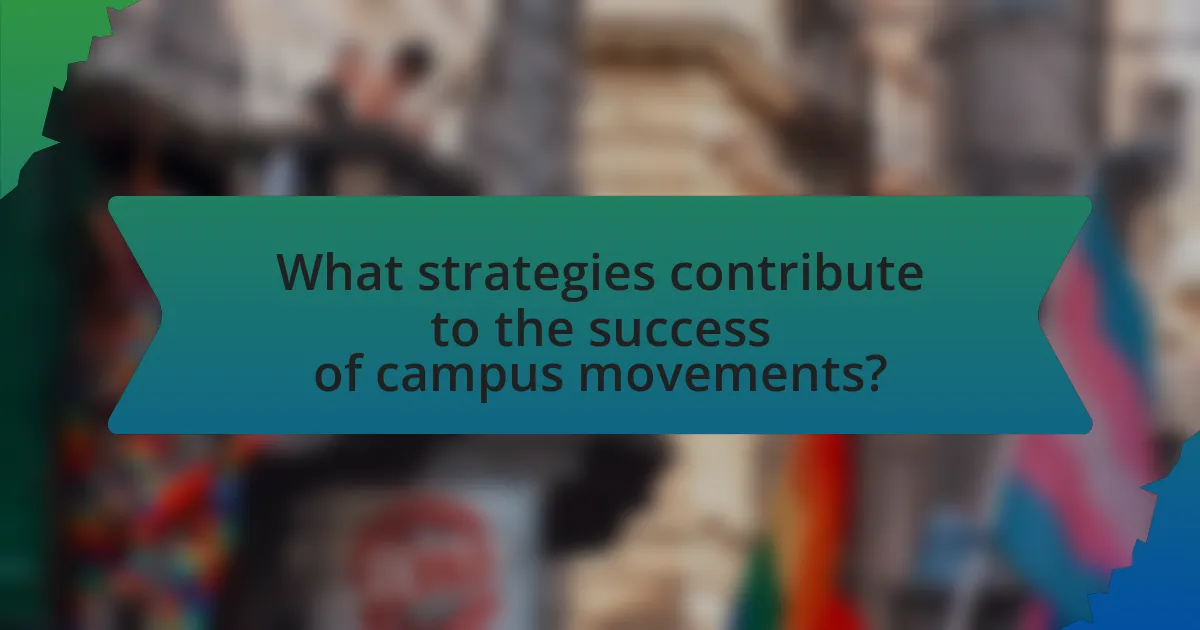
What strategies contribute to the success of campus movements?
Effective strategies that contribute to the success of campus movements include coalition building, clear messaging, and strategic use of social media. Coalition building allows diverse groups to unite around common goals, enhancing the movement’s reach and impact, as seen in the 2018 March for Our Lives, which brought together students from various backgrounds to advocate for gun control. Clear messaging ensures that the movement’s objectives are easily understood and resonate with a broader audience; for instance, the Black Lives Matter movement effectively communicated its goals through concise slogans and powerful imagery. Additionally, strategic use of social media amplifies the movement’s voice and mobilizes supporters quickly, demonstrated by the viral spread of the #MeToo movement, which galvanized global awareness and participation. These strategies, when effectively implemented, significantly enhance the likelihood of achieving the movement’s objectives.
How do effective communication strategies enhance movement success?
Effective communication strategies enhance movement success by ensuring clear messaging, fostering engagement, and facilitating collaboration among participants. Clear messaging allows movement leaders to articulate goals and objectives, which helps unify participants around a common purpose. For instance, the Black Lives Matter movement effectively utilized social media to disseminate information rapidly, mobilizing supporters and increasing visibility. Engagement is crucial; when participants feel informed and involved, they are more likely to contribute actively. Research shows that movements with strong communication frameworks, such as the Women’s March, achieved higher turnout rates due to effective outreach and community building. Collaboration is also enhanced through communication, as it enables diverse groups to coordinate efforts and share resources, ultimately leading to more impactful actions and sustained momentum.
What role does social media play in mobilizing support?
Social media serves as a crucial tool in mobilizing support by facilitating rapid communication and engagement among individuals and groups. It enables the dissemination of information, organization of events, and creation of communities around shared causes, which can significantly amplify outreach efforts. For instance, during the 2011 Occupy Wall Street movement, social media platforms like Twitter and Facebook were instrumental in coordinating protests and spreading awareness, leading to widespread participation and support. This demonstrates that social media not only enhances visibility but also fosters a sense of belonging and urgency, driving collective action effectively.
How can messaging be tailored to resonate with diverse student populations?
Messaging can be tailored to resonate with diverse student populations by employing inclusive language, culturally relevant themes, and targeted communication channels. Research indicates that students respond positively to messaging that reflects their identities and experiences; for instance, a study by the American Council on Education found that inclusive messaging increases engagement among underrepresented groups by 30%. Additionally, utilizing platforms popular among specific demographics, such as social media channels favored by younger audiences, enhances the reach and effectiveness of the messaging. By integrating these strategies, institutions can foster a sense of belonging and connection among diverse student populations.
What organizational structures are most effective for campus movements?
Decentralized and networked organizational structures are most effective for campus movements. These structures empower individual groups and leaders, facilitating rapid response and adaptability to changing circumstances. For instance, the Black Lives Matter movement on campuses utilized a decentralized approach, allowing various chapters to operate independently while aligning under a common mission. This flexibility enables grassroots participation and fosters a sense of ownership among members, which is crucial for sustained engagement and mobilization. Research indicates that decentralized movements often achieve greater reach and impact, as seen in the success of the Women’s March, which was organized through a network of local leaders rather than a centralized authority.
How do leadership roles influence movement outcomes?
Leadership roles significantly influence movement outcomes by shaping the direction, strategy, and cohesion of the movement. Effective leaders can mobilize resources, inspire participants, and create a unified vision, which enhances the likelihood of achieving specific goals. For instance, in the 2011 Occupy Wall Street movement, strong leadership helped articulate clear demands and maintain participant engagement, leading to widespread awareness of economic inequality. Research indicates that movements with defined leadership structures are more likely to succeed in their objectives, as leaders facilitate communication and decision-making processes, ultimately driving collective action.
What are the benefits of coalition-building among different groups?
Coalition-building among different groups enhances collective power and effectiveness in achieving shared goals. By uniting diverse perspectives and resources, coalitions can amplify their influence, leading to greater visibility and impact on issues. For instance, the United Farm Workers’ coalition in the 1960s successfully combined labor rights with civil rights, resulting in significant legislative changes. Additionally, coalitions can foster innovation through the exchange of ideas and strategies, as seen in the collaboration between environmental and social justice groups, which has led to more comprehensive approaches to sustainability. This collaborative effort not only strengthens advocacy but also builds solidarity among participants, creating a more resilient movement.
What challenges do campus movements face, and how can they be overcome?
Campus movements face challenges such as administrative resistance, lack of funding, and insufficient student engagement. Administrative resistance often manifests as pushback against proposed changes or policies, which can hinder progress. To overcome this, movements can build coalitions with faculty and alumni to gain broader support and leverage institutional influence. Lack of funding can limit the scope of initiatives; therefore, movements should seek partnerships with local organizations and apply for grants to secure necessary resources. Insufficient student engagement can be addressed by utilizing social media and organizing inclusive events that resonate with diverse student interests, thereby fostering a sense of community and urgency around the movement’s goals.
What are common obstacles to mobilization and engagement?
Common obstacles to mobilization and engagement include lack of awareness, insufficient resources, and organizational fragmentation. Lack of awareness often stems from ineffective communication strategies that fail to reach the target audience, resulting in low participation rates. Insufficient resources, such as funding and manpower, hinder the ability to organize events and campaigns effectively. Organizational fragmentation occurs when groups with similar goals do not collaborate, leading to duplicated efforts and diluted impact. These factors collectively impede the ability to mobilize individuals and engage them in meaningful actions.
How can movements adapt to changing political climates?
Movements can adapt to changing political climates by employing flexible strategies that respond to the evolving landscape of public opinion and policy. For instance, successful campus movements often reassess their goals and tactics based on the political environment, utilizing social media to mobilize support and communicate effectively with stakeholders. Historical examples, such as the Civil Rights Movement, demonstrate that adaptability—like shifting from direct action to legislative advocacy—can enhance a movement’s impact. Additionally, research indicates that movements that engage in coalition-building and grassroots organizing are more resilient in the face of political shifts, as they can draw on a broader base of support and resources.
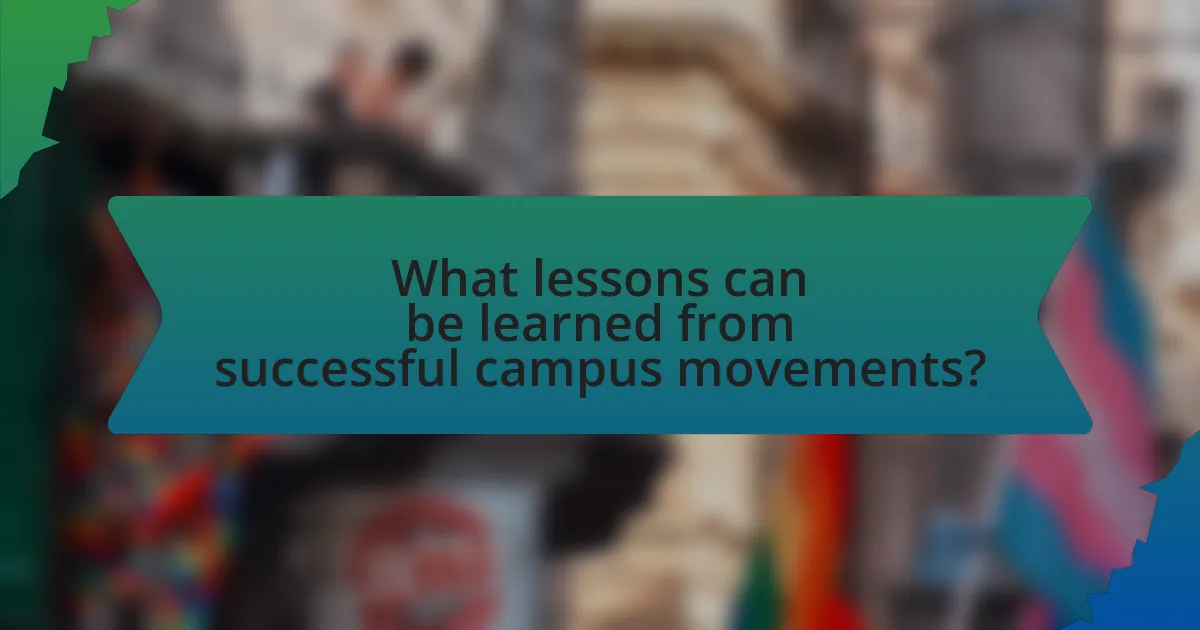
What lessons can be learned from successful campus movements?
Successful campus movements demonstrate the importance of clear goals and effective communication. These movements often achieve their objectives by mobilizing a diverse coalition of students, faculty, and community members, which amplifies their message and increases their impact. For instance, the 2015 University of Missouri protests highlighted the power of collective action in addressing systemic racism, leading to significant administrative changes. Additionally, successful movements utilize social media strategically to organize, inform, and engage supporters, as seen in the #BlackLivesMatter movement on campuses, which has raised awareness and prompted discussions on racial justice. These examples illustrate that clarity of purpose, coalition-building, and strategic communication are critical lessons learned from successful campus movements.
What are the key takeaways from notable case studies?
Key takeaways from notable case studies of successful campus movements include the importance of grassroots organization, effective communication strategies, and the role of coalition-building. Grassroots organization empowers students to mobilize and advocate for change, as seen in the 2018 March for Our Lives movement, which effectively utilized social media to engage a wide audience. Effective communication strategies, such as clear messaging and storytelling, have proven essential in rallying support, exemplified by the #MeToo movement on college campuses, which raised awareness about sexual assault. Coalition-building among diverse groups enhances the impact of movements, as demonstrated by the Black Lives Matter movement, which united various student organizations to address systemic racism. These elements collectively contribute to the success of campus movements, as evidenced by their ability to influence policy changes and foster community engagement.
How can these lessons be applied to current and future movements?
Lessons from successful campus movements can be applied to current and future movements by emphasizing strategic organization, clear messaging, and coalition-building. For instance, the successful mobilization seen in movements like the March for Our Lives demonstrates the importance of unifying diverse groups around a common goal, which can enhance visibility and impact. Historical evidence shows that movements with well-defined objectives and inclusive strategies, such as the Civil Rights Movement, achieved significant legislative changes, indicating that these principles remain relevant. By adopting these lessons, contemporary movements can increase their effectiveness and sustainability in advocating for social change.
What mistakes should be avoided based on past experiences?
Mistakes to avoid based on past experiences in campus movements include lack of clear goals, insufficient communication, and failure to engage diverse stakeholders. Clear goals are essential; movements without them often lose direction and momentum, as seen in the 2015 University of Missouri protests, where unclear objectives led to internal conflicts. Insufficient communication can alienate supporters and hinder progress; for instance, the 2016 protests at the University of California, Berkeley faced backlash due to poor messaging. Lastly, failing to engage diverse stakeholders can limit the movement’s impact; the 2018 March for Our Lives highlighted the importance of inclusivity, as movements that embrace diverse voices tend to gain broader support and effectiveness.
How can students effectively implement these lessons in their activism?
Students can effectively implement lessons from successful campus movements by actively engaging in organized advocacy, utilizing social media for outreach, and collaborating with diverse groups. Organized advocacy allows students to create structured campaigns that address specific issues, as seen in the 2018 March for Our Lives movement, which mobilized students nationwide for gun control. Utilizing social media platforms enables students to amplify their messages and connect with a broader audience, exemplified by the #MeToo movement, which gained traction through online engagement. Collaboration with diverse groups fosters inclusivity and strengthens campaigns, as demonstrated by the Black Lives Matter movement, which united various organizations to address systemic racism. These strategies enhance the impact of student activism by ensuring focused efforts, widespread awareness, and collective strength.
What practical steps can students take to enhance their movement’s impact?
Students can enhance their movement’s impact by organizing strategic campaigns that utilize social media, engage in community outreach, and collaborate with campus organizations. Strategic campaigns amplify visibility; for instance, movements like the March for Our Lives effectively used social media to mobilize support and raise awareness about gun control, resulting in significant legislative discussions. Engaging in community outreach fosters relationships and builds a broader support base, as seen in the Black Lives Matter movement, which successfully connected with local communities to advocate for systemic change. Collaborating with campus organizations can pool resources and increase participation, similar to how various student groups united for climate action, leading to larger demonstrations and heightened awareness on environmental issues.
How can collaboration with faculty and administration improve outcomes?
Collaboration with faculty and administration can significantly improve outcomes by fostering a unified approach to educational goals and resource allocation. When faculty and administration work together, they can align curriculum development with institutional objectives, ensuring that academic programs meet both student needs and administrative standards. This collaboration can lead to enhanced student engagement and retention rates, as evidenced by a study from the University of California, which found that institutions with strong faculty-administration partnerships reported a 15% increase in student satisfaction and a 10% increase in graduation rates. By leveraging diverse expertise and perspectives, such collaborations create a more supportive learning environment, ultimately leading to better academic performance and institutional success.
What best practices should be followed for successful campus activism?
Successful campus activism requires clear goals, effective communication, and strong coalition-building. Establishing specific, measurable objectives helps activists focus their efforts and gauge progress. Effective communication, both within the group and with the broader campus community, ensures that messages resonate and mobilize support. Building coalitions with diverse groups enhances credibility and expands reach, as seen in movements like the 2018 March for Our Lives, which united students, parents, and activists to advocate for gun control. These practices are essential for creating impactful and sustainable activism on campus.
What strategies ensure sustained engagement and momentum?
Sustained engagement and momentum in campus movements are ensured through consistent communication, inclusive participation, and strategic goal-setting. Consistent communication keeps members informed and motivated, fostering a sense of community and shared purpose. For example, regular updates via social media and newsletters can maintain interest and involvement. Inclusive participation encourages diverse voices, enhancing creativity and commitment; research shows that movements with broader representation tend to sustain engagement longer. Strategic goal-setting provides clear objectives, allowing members to track progress and celebrate achievements, which reinforces motivation. A study by the Harvard Kennedy School found that organizations with specific, measurable goals are more likely to maintain momentum over time.
How can movements measure their effectiveness over time?
Movements can measure their effectiveness over time by establishing clear, quantifiable goals and tracking progress against those objectives. For instance, a movement focused on increasing student enrollment in a specific program can assess effectiveness by monitoring enrollment statistics before and after campaign initiatives. Additionally, surveys can gauge participant engagement and sentiment, providing qualitative data on the movement’s impact. Historical examples, such as the Civil Rights Movement, demonstrate that tracking legislative changes and public opinion shifts can serve as indicators of effectiveness, showcasing how movements can adapt strategies based on measurable outcomes.
